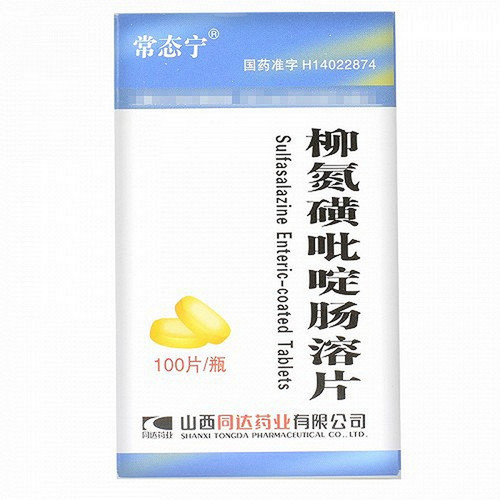Product Overview
[Drug Name]
Trade Name: Mesalazine
English Name: Mesalazine Enteric-coated Tablets
Chinese Pinyin: MeiShaLaQinChangRongPian(ZeNiKang)
[Ingredients]
Mesalazine.
[Properties]
This product is an enteric-coated tablet. After removing the coating, it appears off-white to slightly reddish.
[Indications]
1. For the treatment of ulcerative colitis: including treatment during acute attacks and maintenance therapy to prevent relapses; 2. For the treatment of acute attacks of Crohn's disease.
[Dosage and Administration]
Adults: Based on individual patient needs, the recommended daily dosage is as follows: Crohn's disease: During acute attacks, take 2 to 6 tablets at a time, 3 times a day; total daily dose: 1.5g to 4.5g. Ulcerative colitis: During acute attacks, take 2 to 4 tablets at a time, 3 times a day; total daily dose: 1.5g to 3.0g. Maintenance: Take 2 tablets at a time, 3 times a day; total daily dose: 1.5g. Conventional Dosage: Take one hour before breakfast, lunch, and dinner. The tablet must be swallowed whole with plenty of liquid (do not chew). For optimal therapeutic effects, continuous, regular use is recommended during acute attacks and maintenance therapy. The duration of treatment will be determined by your physician. Internationally, the recommended course of treatment for acute attacks of ulcerative colitis or Crohn's disease is 8-12 weeks.
[Adverse Reactions]
May cause mild stomach discomfort. Occasionally, nausea, headache, and dizziness may occur.
[Contraindications]
1. Hypersensitivity to mesalamine, salicylic acid, and its derivatives, or any of the excipients in this product; 2. Renal or severe hepatic impairment; 3. Gastric or duodenal ulcers; 4. Patients with a predisposition to bleeding (prone to bleeding).
[Precautions]
1. At the physician's discretion, blood counts (differential blood count, liver function parameters such as ALT or AST, serum creatinine) and urine analysis (test strip or urine sediment) should be performed before and during treatment as necessary. It is recommended to check these parameters 14 days after starting treatment, and then further review them 2-3 times every 4 weeks thereafter. If test results are normal, routine checks should be performed every 3 months. If other symptoms are observed, relevant tests should be sought immediately. 2. This product should be used with caution in patients with liver dysfunction. 3. This product should not be used in patients with renal dysfunction. If renal function worsens during use of this product, mesalazine-induced nephrotoxicity should be considered. 4. Patients with pulmonary dysfunction, especially asthma, should use this product under the close supervision of a physician. 5. Patients allergic to medications containing sulfasalazine should use this product under the close supervision of a physician. If acute intolerance reactions (such as convulsions, acute abdominal pain, fever, severe headache, and rash) occur, treatment should be discontinued immediately. 6. In rare cases, undissolved mesalazine enteric-coated tablets may be observed in the stool of patients who have undergone ileocecal resection and ileocecal valve resection. This is due to the rapid passage of this product through the intestines. Please read the instructions carefully and use according to your physician's instructions.
[Use in Special Populations]
Precautions for Children:
Due to a lack of experience with this product in children of the relevant age group, it is not recommended for use in children.
Precautions for Pregnancy and Lactation:
Pregnancy: Mesalazine can cross the placenta. Currently, there are limited clinical data and no relevant epidemiological data on its use in pregnant women. This product should only be used in pregnant women if the expected clinical benefit outweighs the potential risk to the fetus. Animal studies using oral administration have shown no direct or indirect adverse effects of mesalazine on pregnancy, embryogenesis, or fetal development. Lactation: Small amounts of mesalazine and N-acetyl-5-aminosalicylic acid are excreted in breast milk. Experience with mesalazine use in lactating women is limited. Allergic reactions, such as diarrhea, cannot be ruled out in infants. This product should only be used in lactating women if the expected clinical benefit outweighs the potential risk to the infant.
Precautions for Elderly Patients:
Mesalazine should be used at a reduced dose in elderly patients.
[Drug Interactions]
Specific drug interaction studies have not been conducted for this product. Concomitant use of this product with the following medications is suspected to result in potential interactions: 1. Coumarin anticoagulants: May increase coagulation inhibition (increase the risk of gastrointestinal bleeding). 2. Glucocorticoids: May increase gastric adverse reactions. 3. Sulfonylureas: May increase hypoglycemic effects. 4. Methotrexate: May increase the potential toxicity of methotrexate. 5. Probenecid or sulfinpyrazone: May decrease uric acid excretion. 6. Spironolactone or furosemide: May reduce diuretic effect. 7. Rifampicin: May reduce anti-tuberculosis effect. 8. Azathioprine or 6-mercaptopurine: May increase myelosuppressive effects.
[Pharmacological Actions]
The mechanism of mesalazine's anti-inflammatory effects is not fully understood. In vitro studies have shown that mesalazine has a certain effect on intestinal mucosal prostaglandin levels, scavenges reactive oxygen free radicals, and may inhibit lipoxygenase. This product is an enteric-coated tablet of mesalazine, which releases mesalazine in the intestine after oral administration. After reaching the intestine, mesalazine primarily acts locally on the intestinal mucosa and submucosa. Mesalazine bioavailability or plasma concentrations are not associated with therapeutic efficacy. Toxicology studies have shown that repeated oral administration of high-dose mesalazine can cause nephrotoxicity (renal papillary necrosis, proximal tubular epithelial damage, or whole nephron damage). The clinical relevance of these findings is unclear. Animal studies have not shown mesalazine to be mutagenic, teratogenic, or carcinogenic.
[Storage]
Store in a sealed container away from light.
[Specifications]
0.25 g
[Packaging]
Aluminum-plastic packaging. 24 tablets per box.
[Expiration Date]
24 months
[Approval Number]
National Medicine Standard H20103359
[Manufacturer]
Company Name: Heilongjiang Tianhong Pharmaceutical Co., Ltd.








